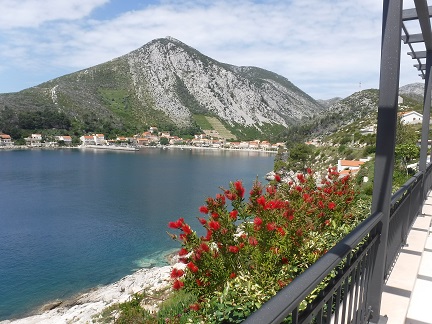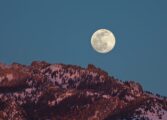By Page H. Gifford
Correspondent
Despite a bloody civil war that tore Yugoslavia apart, Croatia – which was once part of the former Yugoslavia and its communist regime – now stands with its own identity. Sue and Allan Mink took a three-month sojourn to Croatia from March to June of this year, to discover everything historical and beautiful about this often overlooked travel destination.
Sue Mink, a history lover, recognized the destruction left in the wake of the civil war.
There were “three factions: the Croats (mostly Roman Catholic, influenced by that region’s historical ties to Venice), the Bosnians (mostly Muslim, influenced by the time parts of the region were ruled by the Ottomans) and the Orthodox,” she said. “Although all three factions committed atrocities, in the region we were in, the Bosnians suffered the most. Entire villages were burned, there were mass executions of civilians and people were violently uprooted. Now, there are still scars, but the people who once lived peacefully side by side are trying to do that again. I think that in many cases, they still don’t like each other, but they like war a lot less. This tension was a lot more evident in Bosnia-Herzegovina because the three factions are still all there. Croatia is strongly Roman Catholic and more homogeneous, so the recovery there has been a lot easier.”
Game of Thronesfans might know that Dubrovnik, where the Minks stayed, is the setting for King’s Landing – although they added important Game of Thronesbuildings into the landscape that are not genuine to the area.
“Dubrovnik is a spectacularly beautiful city. It’s impossible not to be impressed whenever you see it,” she said. “The water is a turquoise blue, the islands dotted out in the water are breathtaking, and there’s no describing seeing Dubrovnik’s famous city walls.” She added that the old section of the city is very small – just 34 acres. When they arrived in March, she said it was wonderful to go down and walk the old town, but by the time they left in early June, they avoided it as much as possible. Tour buses jammed the entrances by the city gates, and as many as five cruise ships were there at one time. It was very difficult to walk the streets due to the crowds.
“They are going to initiate tickets next season to attempt to reduce the people on the streets, but while I see the need, that will change the character of the town, making it more a Disneyland than a living, vibrant city,” Sue Mink said. “We loved the region around Dubrovnik, but as we got more into the tourist season, liked the city itself less.” However, she stressed that while visiting Croatia, Dubrovnik is a must-see given that so far she has seen nothing comparable to it in her world travels.
One of her favorite places near the city was the Peljesac peninsula.
“It’s Croatian wine country – and the wine can be very, very good. The views are stunning, and there are some beautiful seaside towns in the region,” she said. “My favorite was Korcula, a medieval walled city that was packed with charm, not tourists.” There is a ferry that goes between Korcula and Dubrovnik, and Sue Mink strongly suggested that visitors stay in Korcula and visit Dubrovnik with the ferry, especially during high season.
“We loved the Bay of Kotor in Montenegro, and a real highlight was the Plitvice waterfalls, but that is a good bit north of Dubrovnik,” she said. Plitvice is a series of 27 lakes that cascade down the side of a mountain, creating hundreds of waterfalls. “You can walk on catwalks beneath, around and between the falls, and it’s spectacular. It’s about a five-hour walk that will take your breath away again and again.
“To get more of a flavor of the Bosniak side, in Bosnia, I’d recommend visiting Mostar and Sarajevo,” she continued. “Here, you’ll see minarets and hear the Islamic call to prayer, experiencing a whole different culture.” She suggested visiting Mostar prior to the start of the tourist season starts since it can get crowded.
“Sarajevo is fascinating and a story in itself. It has a strong Ottoman culture, but it was also an important city for the Austrian empire. It was on a street corner in Sarajevo that Emperor Franz Joseph was assassinated, starting the first World War. It’s a dichotomy – there is a line in the sidewalk at one point where, if you face one way, you’d swear you were in Turkey,” she said. Coppersmiths craft their wares, and thick Turkish coffee is enjoyed in tiny cups on tables along the streets. “Just turn around, and you’d think you were in Vienna. Elegant European buildings line the streets and the coffeehouses are dark wood paneled with crystal chandeliers.”
She added that the city still shows signs of devastation from the war, since they were in a siege for nearly four years. “It’s a sobering view of a very recent war, but I was also very impressed by the resiliency and sense of (dark) humor in the city. They are survivors, they have seen the worst, and they made it.”
She said the people were very warm and welcoming once they realized they weren’t passing through on a cruise boat. Her husband, Al, often bicycled into Bosnia and became very friendly with the border guards and the owner of a small café that sat right on the border. Toward the end of their stay, the cook at the café would wave him down as he biked by to come in and have a meal – or a few shots.
“When we mentioned we were Americans, it was common to hear about relatives who escaped the horrors of the war to settle in America, where they were now and how they liked living there,” Sue Mink said. They also became quite close with the family who was hired to care for their apartment, a young, ambitious Bosniak couple with three small children. “They told us about their experiences and how they were working to help the country recover. Belka, the wife, was very involved in politics in the region, even running for a seat on the European Union council for Croatia while we were there. She lost the election, but continued to be actively involved in politics.”
Sue Mink painted a picture of the people as survivors, using their strengths, talents and beliefs to build a better future.
“It’s a powerful experience to have an elderly man point to the ruins of his home in his field of grapes and tell of how his family had to flee for their lives, but that they were able to return and he’s rebuilt his home,” she said. “These are strong, resilient and proud people and they are dedicated to rebuilding their lives there. I admire them.”
Sue Mink said the entire coastline of Croatia has been influenced by several different cultures – but the coastline itself has strong influences from Venice. There are steep mountains only a few miles from the coast that effectively divide the coast from the rest of the region, and that a large part of Croatia is a very narrow strip of land running down the coast – usually only a few miles wide.
“Cross the mountains and you’re in a different world,” she said. “It makes for a fascinating region of different cultures all within a few minutes’ drive from one another.”
For those visiting Croatia for a shorter trip, Sue Mink recommended exploring the coast from the northern town of Zadar down into Montenegro at the Bay of Mostar. Not to be missed are the Plitvice waterfalls, though they are a detour from the coast. Wine connoisseurs in particular should spend some extra time in Split and the Peljesac Peninsula.
“If you want to see Bosnian culture, head to Mostar for an experience you won’t forget,” she said. “Walk the streets of Sarajevo, taking in the dual cultures mixed with the horrors of what war can do and the hope of a people who have risen above it.”





